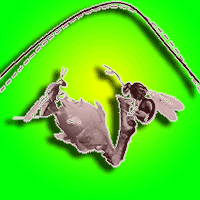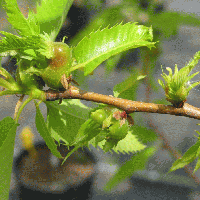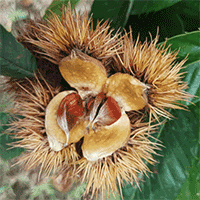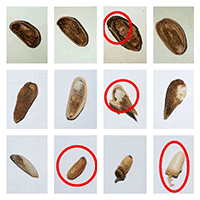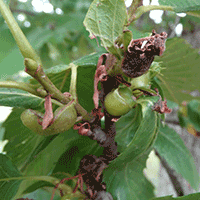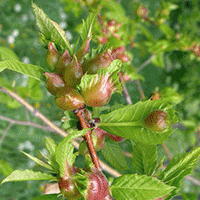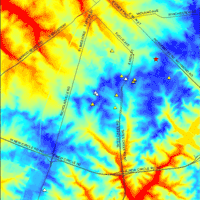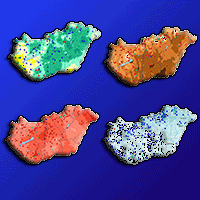Rising temperature can affect forests negatively through its impact on insect pests. The present study focused on two invasive alien insect species (Dryocosmus kuriphilus and Leptoglossus occidentalis) to understand how rising temperature might affect their damage in Turkish forests. For D. kuriphilus, the timing of chestnut budburst, gall induction and emergence of its introduced parasitoid, Torymus sinensis, were monitored between 2015 and 2019, and each phenological event was compared annually with fluctuations in temperature to observe the parasitoid-host synchrony. For L. occidentalis, cumulative degree days (CDD) were calculated, and the possible number of generations produced in 2020 in different regions of Turkey were predicted. The CDD calculations were repeated under increasing temperature and different photoperiod-diapause induction scenarios. Evaluation of the monitoring data on the D. kuriphilus system showed that gall induction occurred at the same time as budburst, whereas T. sinensis emergence was independent from the budburst, and that the parasitoid-host synchrony was disrupted after the abnormally warm winter in 2018. The CDD calculations estimated that L. occidentalis produced one to five generations from north to south in 2020. They also suggested a significant increase in the number of generations in the southern Turkey under temperature increase scenarios. Including photoperiod as a time-limiting factor reduced the highest possible number of generations from five to two. In conclusion, rising temperature has a potential to threaten the biocontrol against D. kuriphilus, and it can increase voltinism in L. occidentalis.
Keywords
, , , ,
Citation
Ipekdal K (2022). Estimating the potential threat of increasing temperature to the forests of Turkey: a focus on two invasive alien insect pests. iForest 15: 444-450. - doi: 10.3832/ifor3960-015
Academic Editor
Anna Loy
Paper history
Received: Sep 01, 2021
Accepted: Aug 24, 2022
First online: Nov 03, 2022
Publication Date: Dec 31, 2022
Publication Time: 2.37 months
© SISEF - The Italian Society of Silviculture and Forest Ecology 2022
Open Access
This article is distributed under the terms of the Creative Commons Attribution-Non Commercial 4.0 International (https://creativecommons.org/licenses/by-nc/4.0/), which permits unrestricted use, distribution, and reproduction in any medium, provided you give appropriate credit to the original author(s) and the source, provide a link to the Creative Commons license, and indicate if changes were made.

Breakdown by View Type
(Waiting for server response...)
Article Usage
Total Article Views: 27269
(from publication date up to now)
Breakdown by View Type
HTML Page Views: 21825
Abstract Page Views: 2541
PDF Downloads: 2479
Citation/Reference Downloads: 0
XML Downloads: 424
Web Metrics
Days since publication: 1159
Overall contacts: 27269
Avg. contacts per week: 164.70
Article Citations
Article citations are based on data periodically collected from the Clarivate Web of Science web site
(last update: Mar 2025)
(No citations were found up to date. Please come back later)
Publication Metrics
by Dimensions ©
Articles citing this article
List of the papers citing this article based on CrossRef Cited-by.
(1)
Arslangündogdu Z, Hizal E (2010)The western conifer seed bug,
Leptoglossus occidentalis (Heidemann, 1910), recorded in Turkey (Heteroptera: Coreidae). Zoology in the Middle East 50 (1): 138-139.
CrossRef |
Gscholar
(2)
Bahar MH, Soroka JJ, Dosdall LM (2012)Constant
versus fluctuating temperatures in the interactions between
Plutella xylostella (Lepidoptera: Plutellidae) and its larval parasitoid
Diadegma insulare (Hymenoptera: Ichneumonidae). Environmental Entomology 41: 1653-1661.
CrossRef |
Gscholar
(3)
Bale JS, Masters GJ, Hodkinson ID, Awmack C, Bezemer TM, Brown VK, Butterfield JEL, Buse A, Coulson JC, Farrar J, Good JEG, Harrington R, Hartley S, Jones TH, Lindroth RL, Press MC, Symrnioudis Watt AD, Whittaker JB (2002)Herbivory in global climate change research: direct effects of rising temperatures on insect herbivores. Global Change Biology 8: 1-16.
CrossRef |
Gscholar
(4)
Barta M (2016)Biology and temperature requirements of the invasive seed bug
Leptoglossus occidentalis (Heteroptera: Coreidae) in Europe. Journal of Pest Science 89 (1): 31-44.
CrossRef |
Gscholar
(5)
Battisti A (2008)Forests and climate change - lessons from insects. iForest - Biogeosciences and Forestry 1: 1-5.
CrossRef |
Gscholar
(6)
Björkman C, Niemela P (2015)Climate change and insect pests. CABI, Boston, MA, USA, vol. 8, pp. 279.
Online |
Gscholar
(7)
Brussino G, Bosio G, Baudino M, Giordano R, Ramello F, Melika G (2002)Pericoloso insetto esotico per ilcastagno europeo [Dangerous exotic insect for the European chestnut]. Informatore Agrario 58: 59-61. [in Italian]
Gscholar
(8)
Cannon RJ (1998)The implications of predicted climate change for insect pests in the UK, with emphasis on non-indigenous species. Global Change Biology 4 (7): 785-796.
CrossRef |
Gscholar
(9)
Cetin G, Orman E, Polat Z (2014)First record of the oriental chestnut gall wasp,
Dryocosmus kuriphilus Yasumatsu (Hymenoptera: Cynipidae) in Turkey. Plant Protection Bulletin 54 (4): 303-309.
Online |
Gscholar
(10)
Colombari F, Battisti A (2016)Native and introduced parasitoids in the biocontrol of
Dryocosmus kuriphilus in Veneto (Italy). EPPO Bulletin 46 (2): 275-285.
CrossRef |
Gscholar
(11)
Demircan M, Gürkan H, Eskioglu O, Arabaci H, Coskun M (2017)Climate change projections for Turkey: three models and two scenarios. Turkish Journal of Water Science and Management 1 (1): 22-43.
CrossRef |
Gscholar
(12)
Di Filippo A, Alessandrini A, Biondi F, Blasi S, Portoghesi L, Piovesan G (2010)Climate change and oak growth decline: dendroecology and stand productivity of a Turkey oak (
Quercus cerris L.) old stored coppice in Central Italy. Annals of Forest Science 67 (7): 706-706.
CrossRef |
Gscholar
(13)
Erlat E, Türkes M (2012)Analysis of observed variability and trends in numbers of frost days in Turkey for the period 1950-2010. International Journal of Climatology 32: 1889-1898.
CrossRef |
Gscholar
(14)
Farinha AO, SiIva JEP, Correia AC, Sousa EMR, Roques A, Branco M (2018)Leptoglossus occidentalis entirely responsible for the high damage observed on cones and seeds of
Pinus pinea? Results from a fertirrigation trial in Portugal. Forest Ecology and Management 429: 198-206.
CrossRef |
Gscholar
(15)
Fent M, Kment P (2011)First record of the invasive western conifer seed bug
Leptoglossus occidentalis (Heteroptera: Coreidae) in Turkey. North-Western Journal of Zoology 7 (1): 72-80.
Online |
Gscholar
(16)
Ferracini C, Pogolotti C, Alma A (2022)A mismatch in the emergence of
Torymus sinensis may affect the effectiveness of this biocontrol agent? Biological Control 174: 105029.
CrossRef |
Gscholar
(17)
Fielding DJ (1988)Photoperiodic induction of diapause in the squash bug,
Anasa tristis. Entomologia Experimentalis et Applicata 48 (2): 187-193.
CrossRef |
Gscholar
(18)
Frazier MR, Huey RB, Berrigan D (2006)Thermodynamics constrains the evolution of insect population growth rates: “warmer is better”. The American Naturalist 168 (4): 512-520.
CrossRef |
Gscholar
(19)
Hance T, Van Baaren J, Vernon P, Boivin G (2007)Impact of extreme temperatures on parasitoids in a climate change perspective. Annual Review of Entomology 52: 107-126.
CrossRef |
Gscholar
(20)
Harrington R, Fleming RA, Woiwod P (2001)Climate change impacts on insect management and conservation in temperate regions: can they be predicted? Agricultural and Forest Entomology 3: 233-240.
CrossRef |
Gscholar
(21)
Harrington R, Woiwod I, Sparks T (1999)Climate change and trophic interactions. Trends in Ecology and Evolution 14: 146-150.
CrossRef |
Gscholar
(22)
Hlásny T, Turčáni M (2009)Insect pests as climate change driven disturbances in forest ecosystems. In: “Bioclimatology and Natural Hazards” (Strelcová K et al. eds). Springer, Dordrecht, Netherlands, pp. 165-176.
CrossRef |
Gscholar
(23)
Ipekdal K, Emin A, Kuzucu AS, Karadag M, Koçluk M, Açici O, Sah S, Aksu Y, Colombari F (2017)Rearing and releasing
Torymus sinensis Kamijo (Hymenoptera: Torymidae), larval parasitoid of the chestnut gall wasp,
Dryocosmus kuriphilus Yasumatsu (Hymenoptera: Cynipidae). Turkish Bulletin of Entomology 7 (2): 113-129.
Online |
Gscholar
(24)
Ipekdal K, Oguzoglu S, Oskay F, Aksu Y, Dogmus Lehtijärvi T, Lehtijärvi A, Can T, Aday Kaya AG, Ozçankaya M, Avci M (2019)Western conifer seed bug
Leptoglossus occidentalis Heidemann (1910) (Heteroptera: Coreidae) current situation in the world and Turkey. Turkish General Directorate of Forestry, Ankara, Turkey, pp. 70.
Gscholar
(25)
Jaramillo J, Chabi-Olaye A, Kamonjo C, Jaramillo A, Vega FE, Poehling HM, Borgemeister C (2009)Thermal tolerance of the coffee berry borer
Hypothenemus hampei: predictions of climate change impact on a tropical insect pest. PloS One 4 (8): e6487.
CrossRef |
Gscholar
(26)
Jaworski T, Hilszczanski J (2013)The effect of temperature and humidity changes on insects development their impact on forest ecosystems in the expected climate change. Forest Research Papers 74 (4): 345-355.
CrossRef |
Gscholar
(27)
Karolewski P, Grzebyta J, Oleksyn J, Giertych MJ (2007)Effects of temperature on larval survival rate and duration of development of
Lymantria monacha (L.) on needles of
Pinus sylvestris (L.) and of
L. dispar (L.) on leaves of
Quercus robur (L.). Polish Journal of Ecology 55 (3): 595-600.
Gscholar
(28)
Koerber TW (1963)Leptoglossus occidentalis (Hemiptera: Coreidae), a newly discovered pest of coniferous seed. Annals of the Entomological Society of America 56: 229-234.
CrossRef |
Gscholar
(29)
Koštál V (2011)Insect photoperiodic calendar and circadian clock: independence, cooperation, or unity? Journal of Insect Physiology 57: 538-556.
CrossRef |
Gscholar
(30)
Lehmann P, Ammunét T, Barton M, Battisti A, Eigenbrode SD, Jepsen JU, Kalinkat G, Neuvonen S, Niemelä P, Terblanche JS, Okland B, Björkman C (2020)Complex responses of global insect pests to climate warming. Frontiers in Ecology and the Environment 18 (3): 141-150.
CrossRef |
Gscholar
(31)
MGM (2021)Turkish meteorological service. Web site.
Online |
Gscholar
(32)
Nielsen AL, Chen S, Fleischer SJ (2016)Coupling developmental physiology, photoperiod, and temperature to model phenology and dynamics of an invasive heteropteran,
Halyomorpha halys. Frontiers in Physiology 7: 165.
CrossRef |
Gscholar
(33)
Numata H, Hidaka T (1982)Photoperiodic control of adult diapause in the bean bug,
Riptortus clavatus Thunberg (Heteroptera: Coreidae) I. Reversible induction and termination of diapause. Applied Entomology and Zoology 17 (4): 530-538.
CrossRef |
Gscholar
(34)
OGM (2021)E-map. Forest General Directorate of Forestry, Web site.
Online |
Gscholar
(35)
Parmesan C (2007)Influences of species, latitudes and methodologies on estimates of phenological response to global warming. Global Change Biology 13 (9): 1860-1872.
CrossRef |
Gscholar
(36)
Payne JA, Jaynes RA, Kays SJ (1983)Chinese chestnut production in the United States: practice, problems and possible solutions. Economic Botany 37: 187-200.
CrossRef |
Gscholar
(37)
Péré C, Jactel H, Kenis M (2013)Response of insect parasitism to elevation depends on host and parasitoid life-history strategies. Biology Letters 9 (4): 20130028.
CrossRef |
Gscholar
(38)
Pureswaran DS, Roques A, Battisti A (2018)Forest insects and climate change. Current Forestry Reports 4 (2): 35-50.
CrossRef |
Gscholar
(39)
R Core Team (2017)R: a language for statistical computing. R Foundation for Statistical Computing, Vienna, Austria.
Online |
Gscholar
(40)
Sekercioglu CH, Anderson S, Akçay E, Bilgin R, Can OE, Semiz G, Tavsanoglu C, Yokes MB, Soyumert A, Ipekdal K, Saglam IK, Yücel M, Dalfes HN (2011)Turkey’s globally important biodiversity in crisis. Biological Conservation 144 (12): 2752-2769.
CrossRef |
Gscholar
(41)
SolarTopo (2021)Day length, sunrise and sunset calculator. Web site.
Online |
Gscholar
(42)
Tamai S, Kato K, Kishibe Y, Ando M, Sano J (2007)Effect of climate changes on the species composition and productivity of plant communities in the eastern Mediterranean region of Turkey. The Final Report of the Research Project on the Impact of Climate Changes on Agricultural Production System in Arid Areas, Rihn-Tubitak, Turkey, pp. 107-115.
Gscholar
(43)
Tamburini M, Maresi G, Salvadori C, Battisti A, Zottele F, Pedrazzoli F (2012)Adaptation of the invasive western conifer seed bug
Leptoglossus occidentalis to Trentino, an alpine region (Italy). Bulletin of Insectology 65: 161-170.
Online |
Gscholar
(44)
Taylor SJ, Tescari G, Villa M (2001)A Nearctic pest of Pinaceae accidentally introduced into Europe:
Leptoglossus occidentalis (Heteroptera: Coreidae) in northern Italy. Entomological News 112 (2): 101-103.
Online |
Gscholar
(45)
Van Mantgem PJ, Stephenson NL (2007)Apparent climatically induced increase of tree mortality rates in a temperate forest. Ecology Letters 10 (10): 909-916.
CrossRef |
Gscholar
(46)
Watt AD, Leather SR, Hunter MD, Kidd NAC (1990)Population dynamics of forest insects. Intercept Limited, Andover, Hampshire, UK, pp. 408.
Online |
Gscholar
